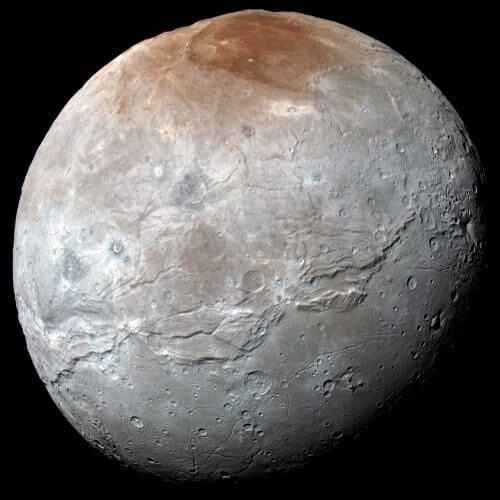The findings from the study of Charon, the largest moon of the dwarf planet Pluto.

Charon is the largest moon of Pluto, its diameter is 1200 km, and in terms of its weight it is 12% of that of Pluto. This raises the possibility that half the moon is rocky and half is ice. Telescopic observations have shown that many parts of its surface are covered with water (1). In telescopic observations made from the observatory in Hawaii, they noticed fingerprints of ammonia hydrates and water scattered on the surface in the form of spots. The possibility was raised that water mixed with ammonia was pushed from the interior of the moon to the surface. Events of this type occur at intervals of a few hours or a few days and cover the ground at a rate of 1 mm every 100,000 years. The process responsible for this is cryovolcanism. Inside the soil thickener there is water in huge quantities that is pushed towards the ground. When the water reaches the surface, it freezes and falls like snow, creating bright spots that can be seen in infrared. Just from the moment the water bursts out it freezes (2).
Charon's poles are very cold. During its year the temperature range ranges from minus 258 degrees to minus 213 degrees. When water bursts out it freezes instantly (3). In its long winter the temperature at the poles approaches absolute zero (4).
It turned out that the coffin was covered in craters and canyons. One of these malls is particularly large. It is bigger than the biggest mall in the USA. This mall is located a little north of the equator. Its length is 1800 km and its depth is 7.5 km, and it is somewhat reminiscent of Mars' Vallis Marineris in terms of its dimensions and location. It covers about half the circumference of Charon. These are tectonic processes on a global scale (5).
The photographs also show mountains and rockslides. One of the mountains is extremely strange. It is high and around it is a ditch that looks like a protective ditch. They failed to give any explanation for this (6). In the North Pole there is a large red area and there is a tholin layer (7). It could be that this is an impact crater (the author's hypothesis - Haim Mazar).
There are also craters. One crater is located near the equator, 96 km in diameter, its center is dark and around the crater bright rays. It could be that the impacting body that created this crater exposed different types of icy material, which is why the center is dark. The crater was probably formed a billion years ago (8). In another crater named Organa, some of the material contains a large amount of frozen ammonia (9).
Sources
- Exactly 37 Years after Its Discovery, Pluto's Moon Charon Is Being Revealed, June 22, 2015
- Charon: An Ice Machine In The Ultimate Deep Freeze, July 21, 2007
- New Horizons Probes the Mystery of Charon's Red Pole,
- PIA20375 : Charon's night side
- Pluto's 'Hulk-like' Moon Charon: A Possible Ancient Ocean?, February 18, 2016
- Pluto's Big Moon Charon Has a Bizarre Mountain in a Moat, July 16, 2015
- Initial Pluto flyby science results published, William Harwood, October 16, 2015
- Cliffs, chasms and craters revealed in the latest New Horizons images, Stephen Clark, 13 July 2015
- ?PIA20036: The Youngest Crater on Charon
